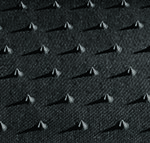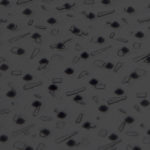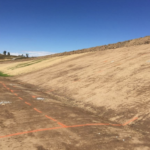Problem
Final closure systems for coal combustion residuals (CCR) landfills will typically incorporate geomembranes to control post-closure infiltration. In order to prevent geomembrane punctures, construction specifications typically limit the maximum particle size of the cover soil to 1 in (2.5 cm), limit the size of protrusions in the geomembrane subgrade to 0.5 in (1.3 cm), and permit only low-traffic loads. Requirements for handling the closure of CCR landfills are defined in U.S. Code 40 Part 257.102 (1).
Situations that exceed these maximum particle size requirements will require either the use of a thicker protective geotextile or increased effort during site preparation—two options that will significantly increase the cost of installing the final cover.
Solution
In an effort to manage costs, engineers described a method in a recent case study to improve closure system performance and construction efficiency by designing a CCR final closure using an integrated drainage system (IDS). The design would increase to the maximum particle size of the cover soil to 9 in (23 cm), increase the maximum subgrade protrusions to 1 in (2.5 cm), and support heavy traffic loads of 45 tons over the cover soil on the bench (2).
The final closure system design incorporated the follow layers:
- A minimum soil layer of 6 in (15 cm) overlaying the CCR
- 50 mil (1.25 mm) AGRU Super Gripnet®, a HDPE geomembrane liner
- 8 oz/yd2 (271 g/m2) AGRUTEX 081, a nonwoven geotextile
- A minimum soil layer of 18 in (0.46 m) overlaying the geomembrane and geotextile.
For closure applications, the Super Gripnet drainage studs are installed facing up and covered with a nonwoven geotextile to provide the required filtration. The drainage layer produced between the geotextile and IDS geomembrane provide transmissivity values that can exceed conventional geocomposite under typical capping conditions. In addition to the superior drainage properties, the friction spikes on the bottom side provide excellent interface shear strength against the soil.
To verify that the design could meet the required performance specifications, a test pad was constructed on the landfill site according to Geosynthetic Institute guidelines (GRI GS11, 3). The test pad measured 46 ft wide by 103 ft long, featured an upper and lower bench, and a 3:1 slope.
Outcome
After the test pad was constructed and covered using a low-ground–pressure dozer, a 45 ton truck made 100 passes over a portion of the test pad. At this point, sections of the test pad were retrieved for analysis in 2016 and again in 2018. Both evaluations showed that the IDS test pad was not punctured by subgrade protrusions of up to 1 in (2.5 cm) or cover soil rocks of up to 9 in (23 cm). The case study demonstrates an effective means of decreasing the installation cost and improving closure system performance through the use of an IDS. Equally as important, the engineers show the value of using onsite test pads and other construction quality control measures to test and verify design decisions. Though the case study indicates it may be possible to increase the maximum particle size specification using IDS, AGRU recommends site-specific testing prior to construction.
Citations
- “Criteria for conducting the closure or retrofit of CCR units.” S. Code 40 CFR § 257.102. Accessed online 31 October 2019. https://www.law.cornell.edu/cfr/text/40/257.102.
- Balsamo, N. J. et al., “CCR Landfill Final Cover Test Pad.”
- “Constructing Test Pads to Assess Protection Materials Intended to Avoid Geomembrane Puncture.” Geosynthetic Institute. (2012).
Overview
- 50 mil (1.25 mm) AGRU Super Gripnet
- 8 oz/yd2 (271 g/m2) AGRUTEX 081
Download Resources
Need Help Determining Which Product is Right For Your Application?
Interested in learning more about how one of our products can make a difference in your next project? Please reach out to us with your questions and one of our sales or technical staff will be happy to assist you.
We can help you determine your exact product or application-related needs. And because our products meet, and often exceed, industry standards you can rest assured knowing that you are getting the best solutions in the business.






